|
 Research
process Research
process
 Problems
of using Freemind Problems
of using Freemind
*Students’
thoughts:
By Pei-hsuan Hsu
Using
Freemind was a lot of fun because we were
allowed to choose the illustrations we loved and
type our own words. Freemind was also useful
because we could save our data, making it more
convenient to find the information we needed in
the database.
By Hui-yu
Yan
Today we were trained to use Freemind, which was
a lot of fun and a good training because we were
able to save the illustrations we liked in it
and typed our own words. Freemind made it so
convenient for us to reuse the data we found.

 Using
digital cameras and camcorders Using
digital cameras and camcorders
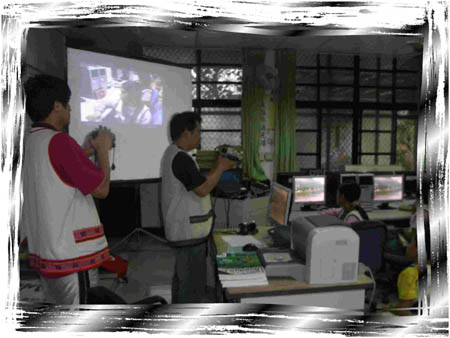 |
|
The process of producing projection
through camcorders. |
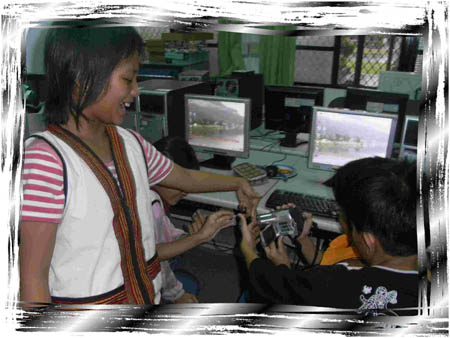 |
|
The practice of using shooting
equipments. |
*Students’
thoughts:
 Using
digital cameras Using
digital cameras
Yu-chi Gao:
Directions of using digital
cameras
1.
Avoid touching the lenses before shooting.
2.
Steadily fix the cameras with the rings.
3.
Make sure the camera focuses on the right
objects.
4.
Avoid using flash in some public occasions.
5.
Avoid touching other parts of the camera when
shooting.
Team
3 was thought to have the best shooting skills
because their photos were very clear and bright.
 Using
digital cameras Using
digital cameras
Yu-ling Wen:
Directions of using digital
cameras.
1. Make sure the camera
focuses on the right objects.
2. Avoid shaking hands when
shooting.
3. Make sure the correct
buttons are pressed.
4. Put the rope next to the
camera around one hand to avoid dropping the
camera.
5. Avoid zooming in and out
repetitively to produce high-quality films.
6. Take people's upper
bodies.
I would like to thank the
teachers for teaching us how to use digital
cameras. I was happy today because we
interviewed the teachers and classmates.
Hui-yu
Yan:
Directions of using digital
cameras.
1. Avoid shaking the camera
during the process.
2. Avoid pressing the wrong
buttons.
3. The speaker has to be
courageous and poised when shooting takes place.
4. Avoid shooting in a crowd.
5. Be well-prepared before
shooting.
Today the teacher talked
about
Sinbaiyang, which was a lot of fun because all
of our films were very funny.
We visited many places today,
including the speech stage and music classrooms
because we were asked to shoot. As a team
leader, I asked my team members to finish the
work assigned to them. The entire process was
very time and energy consuming; however, our
hard work has paid off because the results were
satisfying.

 Interviewing
the elders Interviewing
the elders
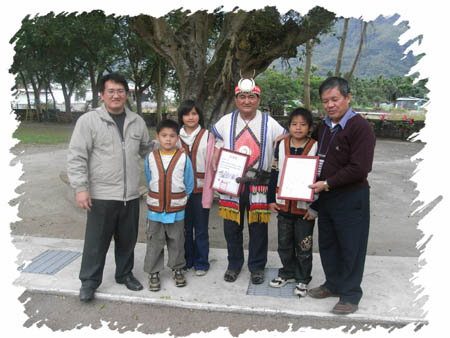 |
|
We took photos with the principal of
Hualien County Tong Lan Elementary
School and Mr.You-hsiang Hsu, one of
the elders. |
(1) Before the interview
1. Deciding the questions
We
spent a lot of time deciding which questions we
would like to ask. In addition to collecting
relevant information, participating in the
Thanksgiving Ceremony in Wanrong Township, and
holding simulation interviews, we also planned
and processed the questions through
Freemind under the
supervision of the teachers.
2. Using web phones, digital
cameras, digital camcorders, digital camcorders
and Dictaphones
Web
phones, digital cameras, digital camcorders,
digital camcorders and Dictaphones were all
necessary tools during interviews. The teacher
taught us how to use them in detail and made us
practice again and again.
Voice
recording and films were much better ways of
recording the interviews than handwriting in
terms of the speed; however, permission from the
interviewees must be gained in advance.
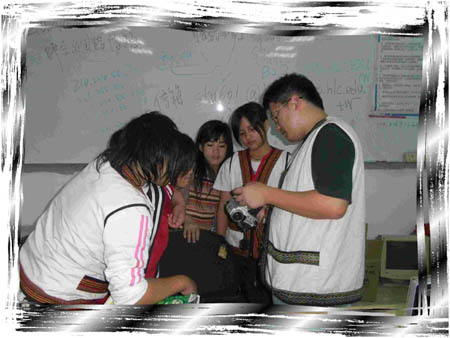 |
|
Learning how to operate the
equipments. |
3. Contacting the
interviewees
We
contacted the interviewees through the phone in
advance and decided the time and location of
interviewees if the person accepted our
invitation.
We
would also politely mention our motivation and
the direction of our questions through the phone
to show our sincerity.
In
addition, we would provide a copy of our
questions to the interviewees so they could be
prepared to show our respect.
4. Locations
The
locations of the interviews were mostly nearby
schools or other places with broadband Internet
access since our interviews were held through
web cameras and phones.
5. Assigning works
The
major works were assigned to different team
members. Interview personnel were in charge of
interviewing people; Note taking personnel were
in charge of recording the interviews; shooting
personnel were in charge of recording the
interviews through cameras or camcorders and
taking pictures of interview personnel and
interviewees while voice recording personnel
were responsible for providing detailed
information about the interviews.
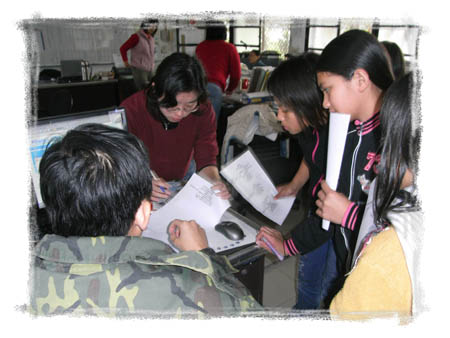 |
|
Preparatory meetings |
(2) During the interviews:
1. Interviewing and notes
taking
The
interview and note taking personnel were
responsible for holding interviews at school
through web cameras and phones. The personnel
took turns asking questions and interacting with
the interviewees while other teams added
relevant questions.
We
uploaded outlines of the interviews soon after
activity was finished and added more detailed
information through voice and film recording
files.
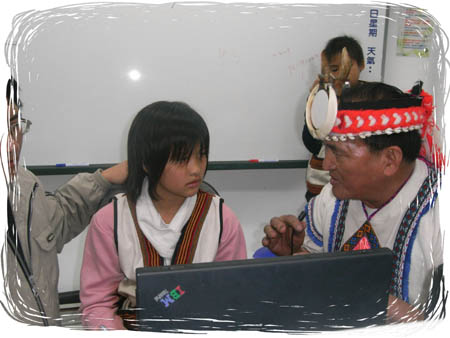 |
|
Interviewing Mr.You-hsiang Hsu, an
Truku elder |
2. Shooting and voice
recording
Our
shooting and voice recording personnel carried
out their works during the interviews. They
recorded the appearances and movements of the
interviewees, which has been a great help for
us, who could not make it to the interview site.
They were even responsible for interviewing or
note taking if the Internet access stopped or
the web camera was out of order.
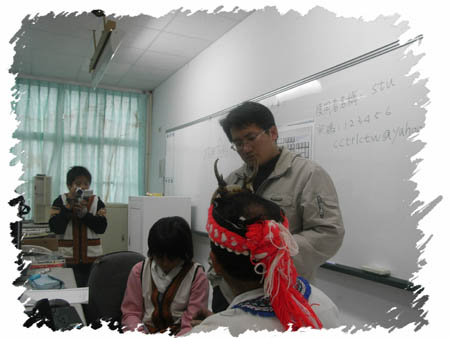 |
|
Director Shou-liang Hsu was in
charge of translation while other
classmates were in charge of
shooting. |
(3) After the interviews
1. Processing the photos,
films and voice recordings
We
added art designs to the photos, films and voice
recorded during the interviews and uploaded them
on-line according to the date.
2. Processing the written
texts
We
recorded the interview content and voice
recording through written texts and divided the
content into different parts according to the
questions. We also planned to have a second
interview if anything is not clear to increase
the profoundness of the interviews.
3. Checking the interview
content with the interviewees
We
double-checked the interview content with the
interviewees to avoid any misunderstanding.
References:
1. yahoo knowledge+, http://tw.knowledge.yahoo.com/question/?qid=1606121505678,
2007.02.08
2. yahoo knowledge+, http://tw.knowledge.yahoo.com/question/?qid=1405121309985,
2007.02.08
*Students’
thoughts:
We held the interviews at
Tong Lan Elementary School and recorded the
content with Jian Ching Elementary School
through Skype.
Yan Wang:
Wen-bin
Hsu, Hao-wei and I followed Director Hsu to Tong
Lan Elementary School in Wenlan Village during
today’s noon break. I was in charge of note
taking; Wen-bin Hsu was in charge of photo
taking while Hao-wei was responsible for
shooting. We did some preparation works such as
turning on the computer, setting up the
microphone, camcorders and prepared the wires.
After
Mr. Yung-hsiang Hsu showed up, we introduced
ourselves to each other before the interview
started. Mr. Hsu (En-ma, in the Truku language)
answered every question in his mother tongue so
I took notes according to the director’s
interpretation. Bagi En-ma talked a lot and
solved all our doubts. After the interview, we
thank the principal of Tong Lan Elementary
School and Bagi En-ma for their help and
returned to our own school!
Today
we had a much better performance than before
that we did not make any mistakes during the
process. I am hoping for an even more successful
interview next time.
Hui-yu Yan:
Today
we were trained to hold interviews through Skype.
The director and some of us went to the school
for an interview with Bagi En-ma. I was in
charge of recording the answers of the elder
through written form while Pei-hsuan Hsu was
responsible for asking questions. I wrote down
important points when it was our turn, during
which Bagi En-ma spoke his mother tongue whereas
Director Hsu had to interpret. I would like to
thank the elder for accepting our interview.

 MIDI
music production MIDI
music production
*Students’
thoughts:
Yan Wang:
We
saved the music notes listed on the paper one by
one and chose the right sound card through
NewzAlert Composer. We listened to the music and
made some changes until it was good enough to be
uploaded on-line. We entered the website of
Jian Ching Elementary
School, chose the web page of the Office of
student affairs, log on to the New Aspen
Cultural Club and uploaded the music.
Today’s activity was a lot of fun because we
could choose the right sound card in the song.
I chose
xylophones
and wood drums though
we were allowed to choose funny instruments
because my music would be uploaded on-line. I
found the second half of my song a bit weird
when I tried to listen to the work I saved. Then
I change one of the musical note which I found
was wrong to make the entire song enjoyable.
Meng-yuan He:
The process of uploading the music was as
follows:
1.
Create some music.
2.
Upload the song to New Aspen.
3.
Add my own music into it.
Today’s
activity was very interesting. We made our own
music and followed the instruction of the
teachers when we confronted problems.

 Editing
the film Editing
the film
*Students’
thoughts:
Hui-yu Yan:
I
produced another film after learning how to use
the New Aspen website and I could not help but
thinking about producing another one because I
enjoyed the process so much. I learned new
skills when I edited the film through the
computer and I recreate a new voice-over because
I did not like the first version. I would like
to thank my classmate next to me who taught me
how to delete the old files, making the entire
process more successful.
After
today’s lesson, I discovered that editing films
was not as difficult as I thought and that only
simple steps were involved. I worked hard and
overcame some difficulties I had.
Yan Wang:
This
has been the second week since we started
learning film editing. I learned how to produce
the opening and ending parts of the film during
today’s lesson. I was so worried when the
voice-over I added last time started to play in
the very beginning of the film that I forgot how
to correct it. I then tried to move the scroll
bar on the side and successfully corrected the
mistake, which made me very happy.
Film
editing was overall a simple skill except for
the voice-over, which sometimes starts to play
in the beginning and needed to be adjusted.
Another problem was the visual effects. I
sometime had to skip those parts because the
effects were not functioning.
Pei-hsuan Hsu:
Today
we learned to add the opening and ending parts
of our films. I finished the work, recorded my
voice-over but discovered a problem with the
ending of the film. The character “Yu” from the
name “Fang-yu Hsu” disappeared resulted from the
form I chose. Teacher Hua told me to change the
form to solve the problem.
The
lesson we took today was a lot of fun. We
learned to produce the beginning and ending
parts of the film. In addition, we added some
pictures into the film, chose the form of
character we liked and change the colors through
the useful functions of the software. I enjoyed
typing and the entire process of film editing. I
was happy because I have become a little
narrator.

 Web
page creation Web
page creation
*Students’
thoughts:
Pei-hsuan Hsu:
We
created our web pages about the Ancestral
Worship Ceremony through the Web Page Wizard in
Frontpage. I would ask other students or
teachers for help when I had difficulties.
I
was happy that I created my own web pages today.
I have been making improvements since the
beginning and I am hoping for greater progress.
The process of creating web pages was
interesting; for example, we had many
illustrations to choose from such as bears,
illustrations relevant to Halloween, daily life
and other fun illustrations. I was very happy
and I would like to thank our teacher for
helping us.
Meng-tze Li:
I
could not understand the instructions the
teachers talked about in class until I started
to ask Teacher Hua questions when creating the
web pages on my own. I then made progress after
I learned the skills. I set a very beautiful
illustration as the home page of the website. I
had a great time today because we could choose
the home page we liked and added information to
it. I will definitely create my own web page in
the future when I have time.

 Interview
records Interview
records
Subject: Interview with Bagi
En-ma
Interview time: Jan. 4, 2008 (Fri.) 15: 00-16:
30, Jan. 11, 2008 (Fri.)15: 00-16: 00
Interviewee: You-hsiang Hsu (En-ma)
Location: Hualien County Jian Ching Elementary
School computer room, Hualien County Shioulin
Township Tong Lan Elementary School
Participants:
Tonglan:
Director Shou-liang Hsu, Yan Wang, Hao-wei Chiou,
Wen-bin Hsu
Jian
Ching: Teacher De-lin Ai, Teacher Shu-jun Hua,
Chi-cheng Ma, Shi-han Yan, Pei-hsuan Hsu, Fang-yu
Hsu, Yu-bo Wen, Hui-yu Yan, Meng-tze Li,
Meng-yuan He
1. What
kinds of people are qualified to be priests?
Bagi
En-ma: First of all, you have to be very
courageous. As you can see, I am a very
courageous elder. Second, you have to have a
strong heart. Third, you need to have a noble
character. If you are the chief of the tribe and
people blame you for your mistakes, you will not
be a qualified chief. Moreover, you have to be
respected by the tribal people, with a humble
and enthusiastic personality. The standard of
being an priest does not depend on your
background, your economic ability, the number of
your pigs or cows or the size of your house but
how enthusiastic or humble you are.
2. Wen-bin
Hsu: What is the process of becoming an priest?
Bagi
En-ma: There
is
a ceremony for this. One must be eloquent, with
the most votes among all the contestants,
courageous, capable of protecting the tribe and
be able to fight against fierce snacks and
beasts.
3. Fang-yu
Hsu: What is the formal clothing of an priest?
According to Director Hsu, Bagi En-ma has put on
the formal clothing an priest wear
during
the ceremonies. Such clothing is not necessaries
when other smaller ceremonies are held.
Director
Hsu asked Bagi
En-ma to show us his clothing.
Bagi En-ma: I only
wear this we I attend ceremonies. The bear bone
on my head ornament is only worn by the priest.
The chief of the tribe always carries a Mother &
Son Knives, which he has used to kill many
animals and therefore are covered by the blood,
flesh
and furs of animals. The chief uses the small
knife to cut the organs of animals and furs
while the big one is used to chop woods and
bones.
4.
Meng-tze Li: What are the meanings your clothing
carries?
Bagi
En-ma: The chief’s clothing is different from
other males in the tribe. The red piece of cloth
is the symbol of his status while other males
only have a piece of cloth covering his body.
Furthermore,
the chief has head ornaments, knives and a
bottle gourd. These are the basic accessories.
5. Wen-bin
Hsu: Why is there a small bell on the clothing?
Bagi
En-ma: This bell is part of the accessories.
Just as the chief and leaders of our tribe, the
priest, as
an important character in the tribe, has his own
accessories. The current accessories we have are
the teeth and bone of beasts and bronze. The
Truku tribe didn't use to have bells; instead,
most of the accessories in the past were the
teeth and bone of beasts and cloth that we made
on our own.
6.Wen-
bin Hsu: Why does the priest wear head ornament
with boar’s teeth?
Bagi
En-ma: Boar’s
teeth are a symbol of heroes. People wear
animals’ body parts on their head ornaments to
show others that they have successfully kill
certain animals and that they are very
courageous.
7. Wen-bin
Hsu: Are there any other accessories?
Bagi
En-ma: People in our tribe share similar
accessories, which we call “Dula” in our
language.
In addition to the knives, we also we have some
unique ones such as a triangle-shaped under
garment covering the belly, which, in Truku’s
language, “Habu”.
8. Wen-bin
Hsu: What is the “Habu” for?
Bagi
En-ma: It
is a red piece of cloth hanging in front of the
chest, usually in red.
9.
Pei-hsuan Hsu: What are the things people should
avoid during the Ancestral Worship Ceremony?
Bagi
En-ma: People
should not fight or argue in front of the tribe.
It is very important for us to keep a peaceful
and happy mind during the ceremony; otherwise,
your wishes for peace and for harvest will not
be realized.
10.
Director Hsu: What are the sacrificial offerings
for?
Bagi
En-ma: We
share good wine with the ancestors.
11.
Pei-hsuan Hsu: I sometimes see people killing
pigs, what is this process for?
Bagi
En-ma: The Ancestral Worship Ceremony is held
once every year to show our appreciation to the
god, during which killing pigs is a very
important part. We kill the pig and separate the
pork. There are 2 different ways of offering the
meat. The 1st one is offering
the penis of the pig to the “Wudu”, which is for
medical purpose; people do this to hope they
stop having bad dreams. The other way of
offering is pointing a certain part of the pork
and shouting “Siousbali”, which is part of the
“Mgahalu” in the Ancestral Worship Ceremony.

Subject:
Interview with the priest of Hongyeh Village
Interview time: Jan. 24, 2008 (Thu) 15: 00-16:
30
Interviewee: Chung-yi Chen Lin
Location: Hualien County Jian Ching Elementary
School Computer Room, Hualien County Wanrong
Township Hongyeh Village
Participants:
Hongyeh: Director Shou-liang Hsu, Yan Wang,
Pei-hsuan Hsu
Jian Ching: Teacher De-lin Ai, Teacher Shu-jun
Hua, Chi-cheng Ma, Hao-wei Chiou, Yu-bo Wen,
Hui-yu Yan, Meng-tze Li, Meng-yuan He
1.
Hao-wei: What are the reeds for?
Bagi:
Reeds are a very sharp kind of grass, which
would cut our skin. When saying the incantation,
reeds serve as a communication tool between us
and our ancestors.
2. Yan
Wang: How do you handle the offerings?
Bagi: We
took out the
organs and the brain of the pig and distribute
the rest of the pork to the relatives.
3.
Pei-hsuan Hsu: What are the types of the
offerings?
Bagi: We
took a small
piece
from every part of the pig such as the liver,
tongue, tail, ear, lean meat, fat, and
intestines as the offerings.

Subject:
Interview with Fu Shih Village, a culture and
history worker
Interview time: Jan. 25, 2008 (Fir) 15: 30-16:
30
Interviewee: Kaji Ciching
Location: Hualien County Jian Ching Elementary
School Computer Room, Hualien County Shioulin
Township Fu Shih Elementary School
Fushih: Director Shou-liang Hsu, Shi-han Yan,
Fang-yu Hsu, Wen-bin Hsu
Jian Ching: Teacher De-lin Ai, Teacher Shu-jun Hua, Chi-cheng
Ma, Hao-wei Chiou, Yu-bo Wen, Hui-yu Yan,
Meng-tze Li, Meng-yuan He
1.
Meng-tze Li: How do you teach people to be
priests?
Director
Kaji: One has to be well-learned and full of
knowledge to be an priest. Furthermore, one
needs to be trained with different skills, such
as hunting, the ability of knowing the time from
the stars and the moon before becoming a priest.
This is just as your ability of predicting the
climate in your science class.
2. Fang-yu
Hsu: What do you do during the ceremonies?
Director
Kaji: We offer
the vegetables we plant such as millets, corns,
sweet potatoes, rice and animals we raise or
hunt to the ancestors. Then we say something
during the ceremony, such as “Gelodan”, when we
kill the animals and offer them to the ancestors
as foods and “Siousi”, with hand gestures and
some sound we produce after the ancestors have
finished eating.
3.
Hao-wei Chiou: What are the offerings during the
ceremony?
Director
Kaji: The crops he plants on his own like
millets, corns and rice. The rest of the
offerings are
small amount of chicken, duck and pork, which
they produce on their own. They offer the
harvest of the year to the ancestors, hoping for
a better harvest during the following year.

 Experience
course Experience
course
 Dance
course Dance
course
 Students:
1st and 2nd grades Students:
1st and 2nd grades
 Education
concept: Education
concept:
We
aim to enable the students to understand the
traditional songs and dances and pass down the
cultures of Truku tribe through giving
traditional weaving songs lessons.
 Course
content: Course
content:
1.
Introduction to the course.
2.
Thoughts sharing.
3.
Truku weaving songs practice .
4.
Traditional weaving dance practice.
5.
Retrospect and achievement performance.

 The
social field The
social field
Version:
Kang Hsuan
 Students:
4th grade Students:
4th grade
 Education
concept: Education
concept:
We
aim to cultivate students’ ability of
appreciating the beauty of their hometown and
the interest of exploring the historical
development of the place through observing
different places of their hometown, the life of
the ancestors, imaging traditional life in the
past and understanding the process of their
hometown’s transformation.
 Course
content: Course
content:
[Activity 1] An overview of traditional
festivals
1.
Understanding the traditional festivals through
experience sharing.
2.
Discussing the stories, customs and meanings of
certain festivals.
[Activity 2] Traditional festivals records
1.
Understanding
the traditional festivals through watching films
and browsing relevant web sites.
2.
Giving thoughts on the relationship between the
meaning, activities and foods of the traditional
festivals of the hometown.
[Activity 3] Understanding the ceremonies of
the indigenous people in Taiwan
1.
Understanding
the traditional festivals through watching films
and browsing relevant web sites.
2.
Discussions and thoughts giving relevant to the
meaning of indigenous people’s traditional
ceremonies.
3. Final
integration: Just as Chinese people who arrange
their festivals through the Lunar Calendar, the
indigenous people sets their own according the
pace of the nature. They show their appreciation
to the god for their harvest through festivals.

 Research
result Research
result
The
Truku people's awe to the ancestors and
conscientious attitude have turned into
traditional ceremonies, hoping for better
harvest and less disasters.
The
traditional ceremonies of Truku cover a broad
range of fields such as the material, spiritual,
natural and artistic fields: from clothing and
offerings to belief and life; from animals and
plants to dances and songs.
Our
research team has generated a strong interest in
the traditional ceremonies of Truku tribe since
we were doing researches on the ramie weaving
skills of the tribe in 2007. We have carried out
relevant researches and explorations during the
courses of the societies on-campus since then.
We devoted our selves in this field during the
past 2 years, aiming to share the interesting
details of the Thanksgiving Ceremony of Truku
tribe such as the music, texts, dances and
photos.
Through
simple instructions, we hope to cover as much
about the ceremony as possible so that more
people will be able to understand the beauty and
energy of the Truku traditional culture.
Nonetheless, we are afraid that we have not
possibly mentioned every detail because there
has been too much involved. These parts will all
become the stepping stone of our future
researches that we will definitely work harder
on.

 Acknowledgement Acknowledgement
We
would like to show our appreciation to
Mr.You-hsiang Hsu, an elder in Hualien County
Shioulin Township Tonglan Village, Chung-yi Chen
Lin, an elder in Hualien County Wanrong Township
Hongyeh Village for accepting our interviews.
Their professional knowledge about the
Thanksgiving Ceremony has been great help and
has enabled us to learn about the rich Truku
cultures.
We
would like to thank Mr.Kaji, a local culture and
history worker of Hualien County Shioulin
Township Tongmen Village and an anthropologist
in Tzu Chi University. His work “Improvisation
and Tanscendence: The
Seejiq
Truku
Village
Ritual and Ancestral Images”
has allowed us to fully understand the
transformation of the Thanksgiving Ceremony.
We
would like to thank Ms. Ching-hsiang Hu for her
“Hualien County Sejiq Truku Traditional
Ballads”, which completely presents the
authenticity of the traditional music of Truku
tribe. We have been very honored to be give the
opportunity of listening to her music, from
which we could experience the vigor and
profoundness in the forests and the mountains.
We
would like to thank Hualien County Wanrong
Township Office, Hualien County Shioulin
Township Office for holding the Truku
Thanksgiving Ceremony, which allowed us and many
others to have a close contact with the lively
traditional Truku cultures.

 Research
team~ New Aspen Cultural Information Club Research
team~ New Aspen Cultural Information Club
We
are a team from Hualien County Jian Ching
Elementary School. As part of Truku tribe, the
traditional cultures of Truku have always been
our favorite research topic. Every week during
the courses of the societies, we carry out
interviews and researches and digitalize the
traditional cultures, bringing the beauty of
Truku tribe to the entire world.
 Students:
3rd, 4th, 5th
and 6th grades Students:
3rd, 4th, 5th
and 6th grades
 Education
concept: Education
concept:
We
introduce the traditional cultures to the
students through information equipments,
increase their interests in this field and
digitalize the content.
 Course
content: Course
content:
1. Cultural
awareness:
►
Participating in activities relevant to
traditional cultures
►
Interviewing people in the tribal workshops to
have a better understanding of traditional
cultures
2.
Feelings:
►
Thoughts sharing after each class
►
Understanding the passing down the traditional
cultures of Truku tribe
3.
Shooting skills:
►
Using digital cameras and camcorders
►
Participating in activities and recording the
content (such as the Ancestral Worship Ceremony
and ramie weaving skills)
►
Film editing
4.
Interview skills
► Communicating
through Skype (a type of web phone)
► Presenting
outlines through Freemind
► Interviews
with the elders
5.
Information skills:
► MIDI
music production
► Simple
web page creation
► Uploading interview records on-lin
► Uploading
thoughts on-line
 Faculties Faculties
|
Names |
Specialties |
|
Director Shou-liang Hsu |
Traditional cultures
Information equipments
Truku tribal language
Film editing |
|
Teacher De-lin Ai |
Freemind
Information equipments
Truku tribal language
Film editing |
|
Teacher Shu-jun Hua |
Interview skills
Information equipments
Film editing |

 References References
1. Interview with Mr. You-hsiang Hsu, a local
elder, at Hualien County Shioulin Township
Tonglan Village, Jan. 04, 2008.
2. Interview with Chung-yi Chen Lin, a local
elder, at Hualien County Wanrong Township
Hongyeh Village, Jan. 24, 2008.
3. Interview with Mr. Kaji, a culture and
history worker, at Hualien County Shioulin
Township Fu Shih Elementary School, Jan. 25,
2008.
4. yahoo knowledge+, http://tw.knowledge.yahoo.com/question/?qid=1405121309985,
2007.02.08
5. yahoo knowledge+, http://tw.knowledge.yahoo.com/question/?qid=1606121505678,
2007.02.08
6. Bulletin of New Aspen Rest Stop, Taroko
National Park, Central Cross-Island Highway,
Tai-8, 143km mark
7. Taroko
National Park websitehttp://www.taroko.gov.tw/HistoryCulture/4_2_2_4/Default.aspx
8. Digital Museum of Zoology, National Taiwan
University—Formosan
Wild Boar,
Mammal Database.
http://archive.zo.ntu.edu.tw/mammal/r_mamm_index.asp?mamm_id=M0058
9. The
distribution of and introduction to the
indigenous people in Taiwan—Truku tribe
(2006.06). http://www.tacp.gov.tw/intro/nine/taroko/taroko1.
HTM.
10.
Digital Museum of Taiwanese Indigenous Peoples
–The traditional cultures of each tribe—the
ceremonial cultures—the ceremony of life--Truku
tribe. http://www.dmtip.gov.tw/Aborigines/Article.aspx?CategoryID=3&ClassID=9&TypeID=20&RaceID=10
11.
Journal of Taiwanese Vascular Bundle Plants,
Vol. 4—Dioscorea
esculenta.
http://subject.forest.gov.tw/species/vascular/4/Book1/index-1.htm
12.
Journal of Taiwanese Vascular Bundle Plants,
Vol. 5—Foxtail
millet.
http://subject.forest.gov.tw/species/vascular/5/index-1.htm
13.
Journal of Taiwanese Vascular Bundle Plants,
Vol. 5—Zea
mays L..
http://subject.forest.gov.tw/species/vascular/5/index-1.htm
14.
Journal of Taiwanese Vascular Bundle Plants,
Vol. 5—Colocasia
esculenta.
http://subject.forest.gov.tw/species/vascular/5/index-1.htm
15.
Walis, N., Yu, G.H. (2002). The History of
the Indigenous People in Taiwan—the History of
Atayal
Tribe.
Nantou: Taiwan Historica.
16. The
Hometown of Chiahsian Taro—Profile of
Colocasia
Esculent—Types of Colocasia Esculent.
http://librarywork.taiwanschoolnet.org/cyberfair2006/jxp1/index2a.htm
17.
Sayama (1918).
Report on
the Survey of Barbarian
Tribe3--Sedeq
tribe. Temporary
Taiwan Old Customs Survey Society.
18. Yu,
G.H. (1981). The Tribal Organization of
East
Seediq
Tribe.
Collected Papers of Academia Sinica Institute of
Ethnology, 50: 91-110.
19. Li,
Y.Y. (1963). The
Atayal
People in South Australia—Ethnology
Field
Research
and Study.
(1). Collected Papers of Academia Sinica
Institute of Ethnology, 5.
20.
Story by Rimui, illustrated by Meimei (2002).
Atayal
Tribe:
The
Rainbow’s Judgment.
Taipei: New Naturalism.
21.
Chiba, T., trans. by Yu, J.R. (1973)
Zea mays
L. in Ming Dynasty Documents.
Scientific Agriculture. 1973: Vol. 21, Issue
5/6. http://seed.agron.ntu.edu.tw/cropsci/maize/yu01.htm
22.
Lin, E.H. (1989) “Report on the Ceremonial
Documents of the Indigenous People in Taiwan”,
Taipei: Ministry of the Interior.
23.
Lin, W.J.. 1996. Foxtail millet. Brochure On
Planting the Grains In
Small
Quantity And
Diversified
Styles.
Department of
Agriculture, Taiwanese
Government.
24.
Hualien District Agricultural Research and
Extension Station—Column for the
Marketing
Class—Agricultural
products
http://www.hdais.gov.tw/10/農特產品/蔬菜/taro.pdf
25.
Hualien County Wanrong Township Office.
International Information Service Web
Site—Introduction to the Departments—Office of
Village Affairs—Jian Ching Village.
(2008.02.03) http://www.wanrung.gov.tw/officesintro/village_jc.aspx
26.
Edited by Hu, C.H. (undated). Hualien County
Seejiq Truku Tribe Traditional Ballads (1).
Hualien County Truku Development Association.
27. The
Traditional Writing System of the Language of
the Indigenous People. (Dec. 15, 2005). Letter
Tau-Yu-Tze-Di#0940163297, Yuan-Min-Chiao-Tze-Di#09400355912.
Taipei: Ministry of Education, Council of
Indigenous Peoples, Executive Yuan.
www.edu.tw/files/list/M0001/aboriginal.pdf
28.
Hsu, M.C. (1989). The Cultures and Customs of
the Atayal Truku Tribe. Commissioned by the
Construction and Planning Agency, Ministry of
the Interior, researched by Academia Sinica
Institute of Ethnology.
29.
Yangmingshan National Park—Taiwanese Wild Boar.
http://www.ymsnp.gov.tw/web/webpage.aspx?f=data_file/animal93/animal93_d3-12.htm
30.
Huang, C.H. (2000). The Hunting Culture of East
Seediq Tribe. Collected Papers of Academia
Sinica Institute of Ethnology, 15: 1-104.
31.
Agriculture Website for KIDS—Mita
Kaleidoscope—Creatures—Botany—Plants—Vegetables--Stem
Vegetables.
http://kids.coa.gov.tw/knowledge.php?type=view&code=A13&id=taita_taita_20080123104914
32.
Agriculture and Food Agency website—Foxtail
millet.
http://www.afa.gov.tw/public_index.asp?CatID=85
33.
Agriculture and Food Agency website—Eatable
Dioscorea esculenta.
http://www.afa.gov.tw/public_index.asp?CatID=77
34.
Tian, C.Y. (2001). The Indigenous People in
Taiwan—Atayal Tribe. Taipei: Taiyuan Publishing.
35.
Tsou, Y.E. (2001). The Hunting Culture Of East
Seediq Tribe And The Management Of National
Parks. Taroko National Park Administration.
36.
Liao, S.C. (1977). The Migration Of The Tribe Of
Atayaleast Seediq Tribe And Its Distribution.
(1). Collected Papers of Academia Sinica
Institute of Ethnology, 44.
37.
Liao, S.C. (1977). The Migration Of The Tribe Of
Atayaleast Seediq Tribe And Its Distribution.
(1). Collected Papers of Academia Sinica
Institute of Ethnology, 45.
38.
Liao, S.C. (1998). The Society of Atayal Tribe.
Hualien: Tzu Chi University.
39.
Liu, Y.L. (2001). Research on the Oral
Narrations of the Story of Seediq Tribe in
Taiwan. Master’s thesis (unpublished), Graduate
Institute of Folk Literature, Hualien Teachers
College.
40. Li,
N.L., Tu, L.C., Chen, P.Y., edited by Liu, H.Y.
(2001). A Complete Guide to the Ceremonies of
the Indigenous People in Taiwan. Taipei: Chang
Min Culture.
41.
Pan, C.D. (2003).
Mountain
Cultivation and The Pacification of Indigenous
People, a Policy in Late Chin Dynasty and the
Transformation of the Power of Truku Tribe in
the Rear Mountains. The Historical cultivation.9:
49-70. Taipei: Graduate Institute of History,
National Taiwan Normal University.
42.
Sejiq People’s Discussion Forum—Report on the
Research into Sisil Birds.
http://groups.google.com.tw/group/sediqyouth/web/sisil
43. Su,
C.C. (2001) Introduction to the National
Produced Delicate Grain Counter. Grains and
Livestock.

|